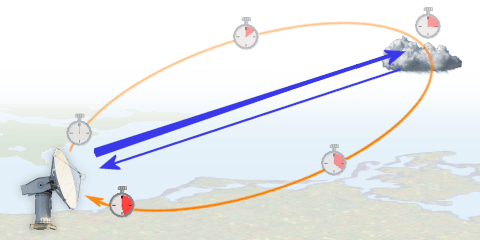Basic Principle of Operation

Figure 1: Weather picture
Basic Principle of Operation
The technical principle of weather radar is very similar to that of Primary Surveillance Radar (PSR) and it suffers from many of the same types of problems.
The most important difference consists that an aim only will be detected at radar unit for the air surveillance (Target visible: yes/no). It will be measured only the coordinates of the aim location. However, at a meteorological radar the echo signal will be estimated. These data finally give information about this, in which intensity and in which consistency reflective objects exist in the observation room.
Several other major operating differences exist. This is often due to the fact that the shape of the “object of interest” is considerably different (weather is normally much larger and more fluid than moving targets for example) and the object velocity is normally considerably less than that of an aircraft or other flying “machine”. Best detection of “weather” objects takes place at different frequencies. (This one having another meaning in the meteorological radar than in a multi-frequency PSR system.)

Figure 2: Radar principle
The familiar diagram shows high power transmissions hitting the object and reflections being scattered back (i.e. reflected or „backscattered”) towards the transmitting antenna to be interpreted by a sensitive receiver system (as well as reflected in a diffuse pattern). The signal is of a particular power (e.g. 850 kW) but the returns echoed of objects and weather are normally quite weak and a highly sensitive receiver is required to identify and interpret these.
For PSR systems, the reflections of interest are those from aircraft and other flying objects. This is quite different to the reflections of interest being weather formations. For PSR, weather is regarded as noise and clutter and is filtered out. For weather radar, reflections from aircraft are a cause of noise and clutter. Both PSR and weather radar systems suffer from problems of ground or terrain clutter, refraction and other sources of noise and clutter.

